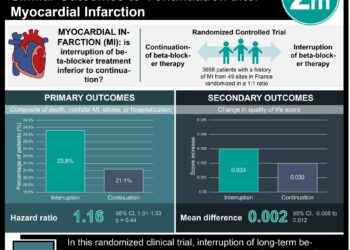Patient age may impact hospital rankings based on acute myocardial infarction mortality data
1. Hospital mortality rankings using data from older patients (≥65 years of age) with acute myocardial infarction (AMI) did not correlate with rankings for younger patients (18 to 64 years of age) with AMI.
2. Integrating data from younger patients into hospital outcomes evaluations would allow for additional analysis of possible quality differences related to age and its effect if present.
Evidence Rating Level: 2 (Good)
Study Rundown: In order to calculate 30-day risk-standardized mortality rates (RSMRs) for patients with AMI, the Centers for Medicare & Medicaid Services (CMS) uses data for Medicare patients ≥65 years of age who are fee-for-service beneficiaries. These 30-day RSMRs are used to rank hospital quality. Although these RSMR values may suggest hospital quality for patients aged ≥65 years, it is unclear if this is also true for patients aged ≤64 years. This retrospective cohort study analyzed the relationship between 30-day RSMRs for patients with AMI aged ≥65 years (older patients), 18 to 64 years (younger patients), and >18 years (all patients). Using AMI mortality data from electronic health records (EHRs), researchers calculated 30-day RSMRs for these three patient groups and used these RSMRs to rank hospitals. The authors found that hospital mortality rankings using data from older patients with AMI did not correlate with rankings for younger patients with AMI. Integrating data from younger patients into hospital outcomes evaluations would allow for additional analysis of possible quality differences related to age and its effect if present.
A strength of the study is that it uses data from 543 794 AMI hospitalizations. A limitation of the study is that the data was obtained from a small fraction of U.S. hospitals.
Click to read the study in Annals of Internal Medicine
Relevant Reading: What distinguishes top-performing hospitals in acute myocardial infarction mortality rates?: A qualitative study
In-Depth [retrospective cohort]: This study uses clinical information obtained from 986 hospitals in the ACTION (Acute Coronary Treatment and Intervention Outcomes Network) Registry—Get With the Guidelines, which is the largest clinical registry of AMI data in the U.S. Using a quality measure for AMI mortality approved by the National Quality Forum, researchers calculated 30-day RSMRs for patients with AMI aged ≥65 years (older patients), 18 to 64 years (younger patients), and >18 years (all patients) and ranked hospitals according to these RSMRs. Researchers found 267 763 AMI hospitalizations in older patients and 276 031 in younger ones. Among older, younger, and all patients, the median hospital 30-day RSMRs were 9.4%, 3.0%, and 6.2%, respectively. Hospitals performing at the top and bottom for older patients also performed at the top and bottom for all patients. However, most hospitals performing at the top and bottom for older patients were not performing at the top or bottom for younger patients, suggesting that incorporating data from younger patients could enhance the accuracy of hospital mortality rankings.
Image: PD
©2017 2 Minute Medicine, Inc. All rights reserved. No works may be reproduced without expressed written consent from 2 Minute Medicine, Inc. Inquire about licensing here. No article should be construed as medical advice and is not intended as such by the authors or by 2 Minute Medicine, Inc.






